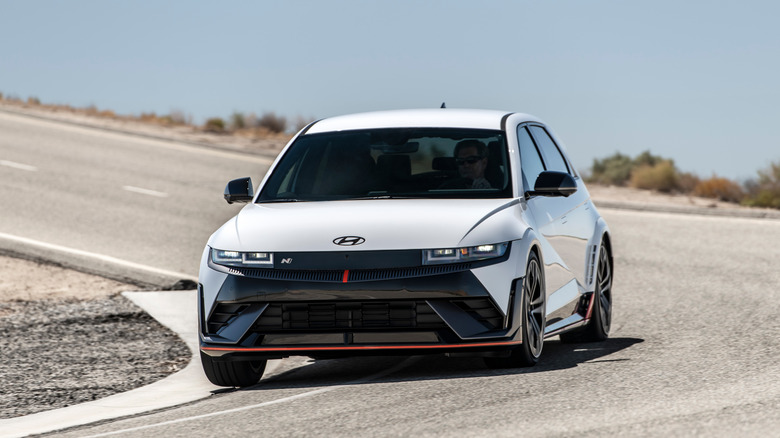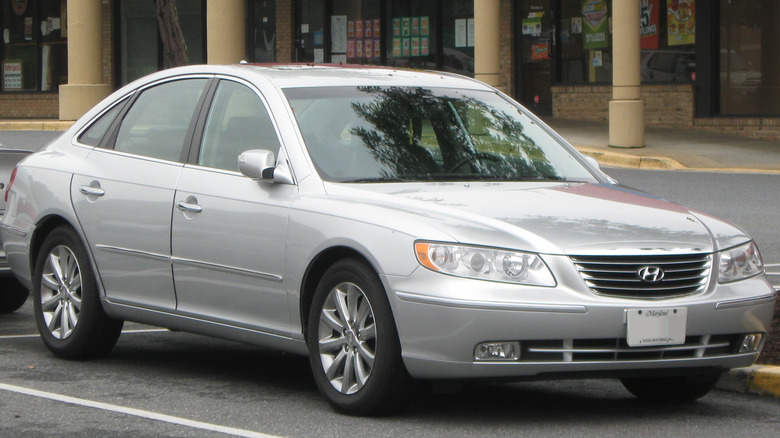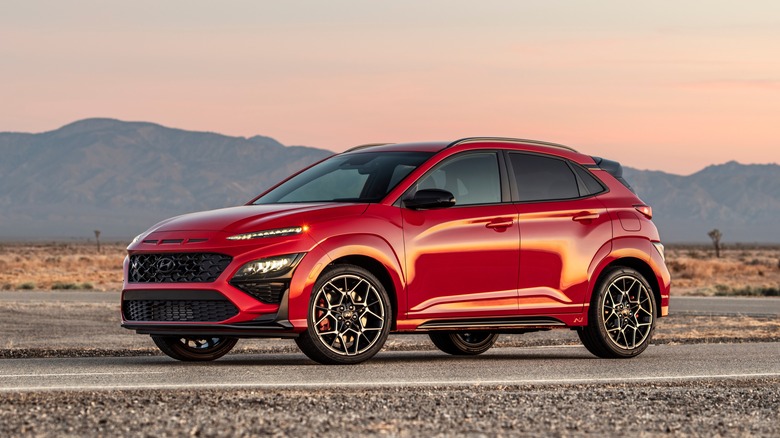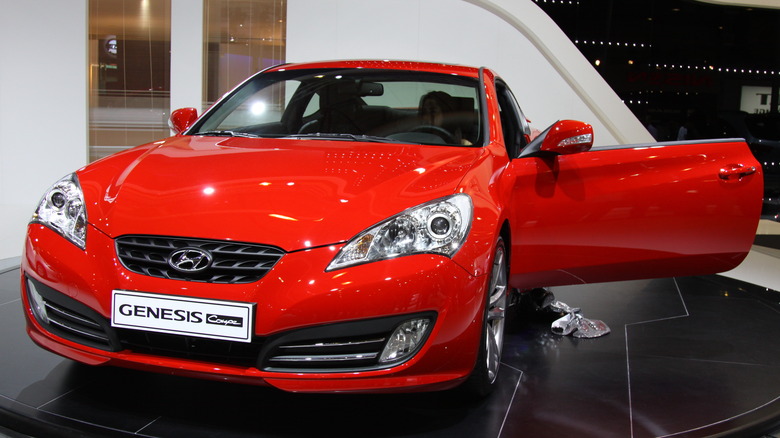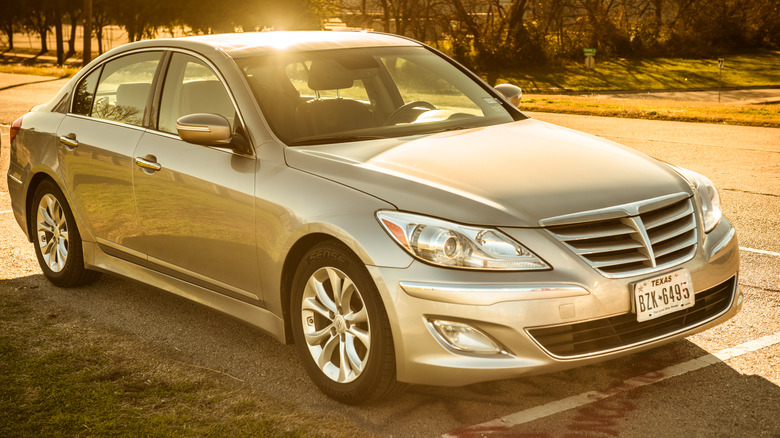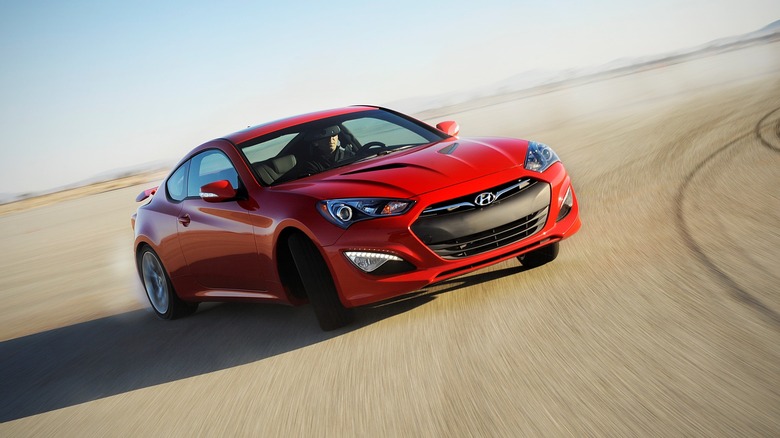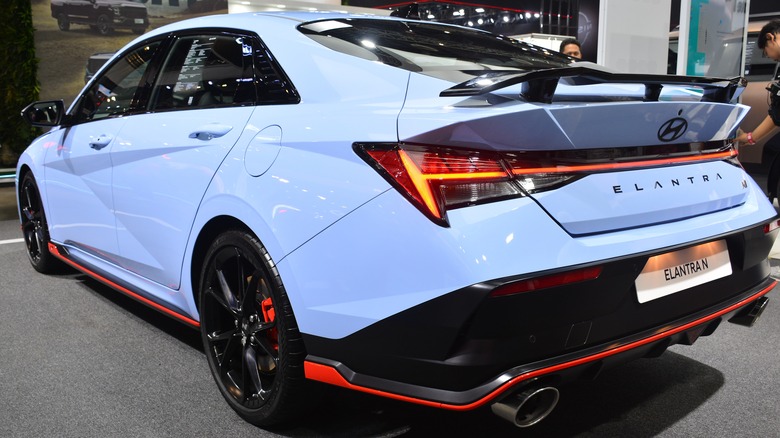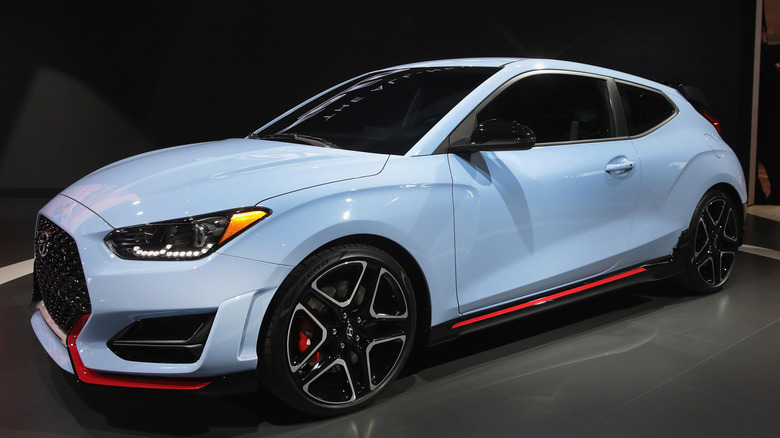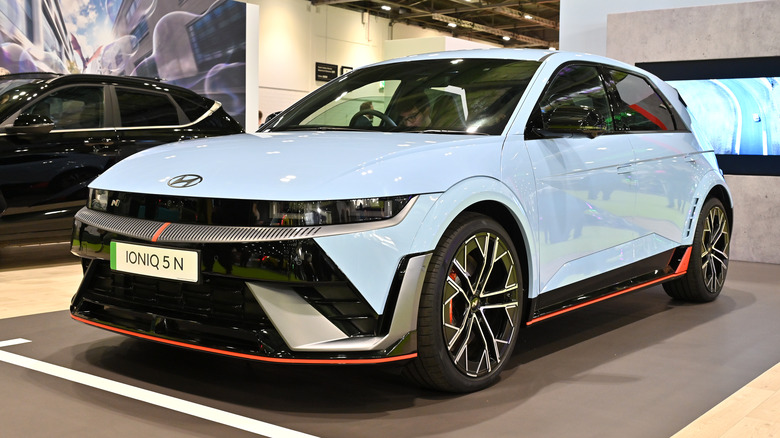8 Of The Fastest Hyundai Cars Ever Made, Ranked By Top Speed
When Hyundai arrived in the United States in 1986, the upstart Korean carmaker didn't offer much for driving enthusiasts to get excited about. Its first car sold in the U.S. was the Excel, a name that was aspirational more than descriptive, at least from a performance perspective. Based on a Mitsubishi Mirage platform, the Excel offered a 68 horsepower four-cylinder engine under the hood.
However, the Excel delivered tremendous value at a base price starting just under $5,000, along with fairly attractive looks for an economy car thanks to Italdesign. Buyers scooped them up to the tune of 169,000 units in just its first year on the U.S. market, laying the foundation for Hyundai to become a major player in the automotive market in America and around the world. With success came the resources to build bigger and better cars.
Today Hyundai manages four marques, making it a true global car manufacturer. However, Hyundai split the Genesis brand into its own luxury marque in Korea in 2015 and in the U.S. the following year, copying the strategy that its Japanese rivals Honda, Toyota, and Nissan used with Acura, Lexus, and Infiniti, respectively. It also owns Kia and has relaunched Ioniq as a standalone EV brand. With global reach, Hyundai is no longer an upstart — it now builds cars and SUVs with world-class performance. The following list counts down to the fastest Hyundai built so far.
2011 Hyundai Grandeur / Azera 3.8
The Hyundai Grandeur, known as the Azera in the U.S. market, offered a nearly anonymous sedan exterior wrapped around a 3.8-liter, 283 horsepower V6 that offered surprising performance. In fact, the car could reach speeds of up to 148 mph, at which point it was limited by a speed governor. The 3.8-liter engine had received a 20 horsepower increase for 2011 compared to the previous model year, boosting it onto this list. There was also a 3.3-liter V6 option with 260 horsepower. A six-speed automatic came standard on all trim levels.
Equipped with the larger of the two motors, the Azera could run from 0-60 in a very respectable 6.3 seconds, making it as quick as sports cars from only 10 or 20 years earlier. Reviewers commended its ride and handling, too, with Motor Trend noting that, "there's relatively little body roll and the ride is comfortable." Car and Driver, however, found it to be less of a sports sedan and declared, "The Azera is happiest on interstates." On highways, its powerful V6 and smooth ride made it an excellent long-distance cruiser.
The Azera offered near-luxury, nearly-sporty performance at a relative bargain of a price, starting at just $25,495 for the GLS with the 3.3-liter and $30,095 for the Limited model. Even adjusting for inflation, that's a very fair price for a gutsy V6-powered sedan. For this price, buyers also got a very roomy interior with more space than a Mercedes E-class. The interior design was dated but well laid out, and the Limited trim level came with standard leather seating. Available tech such as a navigation system helped the Azera to keep pace with its rivals.
2022-2025 Hyundai Kona N
The rowdy little Kona N shows up to the subcompact SUV party with a 276 horsepower, turbocharged four-cylinder bundle of fun under the hood that's good for a top speed of 149 mph. Our reviewers found the Kona N to be "the right sort of silly." It's part of Hyundai's N lineup of performance models, which is named for its research and development center in Namyang, South Korea. Hyundai points out that N is also the first letter of the Nurburgring track where automakers compete to refine their cars' performance and break records. This is a testimonial to Hyundai's ambitions for its N cars, and part of the reason that we'll see more of them on this list.
In the Kona N's case, the Nurburgring would be a great test bed for one of the little SUV's other major upgrades — its suspension. Hyundai fitted an electronic limited-slip differential to the Kona N which it refers to by the cute name of Corner Carving Differential. This offers maximum grip in corners even though the Kona N hasn't been lowered from its regular SUV height. Granted, it's a very small SUV and arguably more of a hatchback, but it still offers decent visibility and utility. Front-wheel-drive is the only layout, however.
The exterior is a riot of extra molding, red trim, and 19-inch wheels wrapped in low-profile rubber, but the interior is much more understated. With 46 cubic feet of cargo space with the rear seats folded down, it's also very practical. Still, the best part of the interior is easy to miss: a small red button on the steering wheel that unleashes the N Grin Shift mode, giving an extra 20 seconds of over-boost and power shifting –- the right sort of silly, indeed.
2010 Hyundai Genesis Coupe 3.8
The Genesis Coupe offered a 306 horsepower V6 for 2010 that was good for a 5.7-second zero to 60 time and a governor-limited 149 mph top speed. A 2.0-liter turbo four was available in the 2.0T model, too. The Genesis Coupe also offered something that was increasingly rare by the time the 2010 model debuted — rear-wheel drive performance. That arguably put it in the same league as sports coupes like the Chevy Camaro and Dodge Challenger, although the Genesis couldn't match their V8 offerings. A closer competitor might be the Nissan 370Z.
While the coupe's base price was a very reasonable $22,000, stepping up to the 3.8-liter V6 would set you back $25,700, which was still reasonable even at the dawn of that decade. While its skid pad grip was a fairly modest 0.87 g, Edmunds noted in their review that the "steering feel and responsiveness are all-time Hyundai bests." They weren't as crazy about the shifter feel, but other reviewers found it satisfying.
The interior featured high-quality materials and attractive lines. Ergonomics were mostly decent, visibility was good for a sports coupe, and the power seats on upper trim levels drew praise. The Genesis Coupe offered a trunk rather than a hatchback, compromising cargo utility, and its tiny rear seat barely accommodated adult passengers. However, for drivers seeking sophisticated style and strong rear-wheel-drive performance, the Genesis Coupe delivered a strong argument for a visit to a Hyundai showroom.
2012-2016 Genesis Sedan
Under the skin of the unassuming, businesslike Genesis Sedan lay the heart of a sports car. There was a choice of three hearts, actually: a 3.8-liter V6 making 333 horsepower, a 4.6-liter V8 with 385 horsepower, or a 5.0-liter V8 that was new for that model year and packed 429 horses under the hood. All three motors delivered power via an 8-speed automatic to the rear wheels, although an AWD model was released in 2015, shortly before Genesis was spun off into its own brand.
Like many Hyundai models, the Genesis sedan had a governor-limited top speed, which in this case was set at 149 mph. It's safe to bet that without this artificial handicap, the 5.0-liter R-Spec could have gone quite a bit faster. Even in a big sedan like this, 429 horsepower can deliver big performance on a long straightaway. Over shorter distances it could still shine, posting a 5.1-second zero to 60 time. R-Spec models also came with a sport-tuned suspension, 19-inch alloy wheels, and other performance upgrades to give it the handling to match its power.
With prices ranging from $35,050 for the base 3.8-liter V6 up to $47,350 for the R-Spec V8, the Genesis sedan was a relative bargain compared to German and Japanese sports sedans. For that price, it also delivered a well-designed interior and a long list of standard features. As with its Genesis Coupe sibling, the Genesis sedan delivered value in addition to performance.
2013-2016 Hyundai Genesis Coupe R-Spec and Track Editions
Hyundai refreshed the Genesis in 2013, which included engine upgrades that were significant enough to earn the model a separate spot on this list. Both its 2.0-liter four-cylinder and its 3.8-liter V6 now offered significantly more horsepower, although a killjoy speed governor still limited the top speed of the V6 to 149 mph. Still, the Genesis Coupe achieved a 5.2-second zero to 60 mph time, which is decent compensation for the truncated top speed.
However, there was still plenty of room between 0 and 149 mph for drivers to have fun with the Genesis coupe. For 2013, the 2.0-liter turbo four received a boost from 210 to 274 horsepower via a twin-scroll turbocharger. On the V6 models, direct injection boosted horsepower to a very healthy 348, an increase of 42 horsepower from the 2012 model. Six-speed manual and eight-speed automatic gearboxes channeled power to the rear wheels. Prices started at $25,125 for a manual-equipped turbo four and ranged up to $35,125 before options for a V6 with the automatic transmission.
For 2013, the Genesis Coupe benefited from an interior upgrade that significantly improved comfort, quality, and refinement over previous models. A paddle shifter provided excellent control over the gearbox. Ambient noise was better than in previous generations. A full array of high-tech features was available, although the R-Spec model left out features like navigation, heated seats, and premium audio, focusing instead on pure performance.
2022-2025 Hyundai Elantra N
The Elantra N, the sportiest version of Hyundai's bread-and-butter family sedan, throws some hot sauce into the recipe. With a top speed of 155 mph, it easily competed with well-known rivals like the Honda Civic Type R while undercutting many of them with its $32,925 entry price when it was introduced for the 2022 model year. Top speed remains the same for 2025, while the price has increased to $35,445, although this is still a bargain compared to the $45,895 2025 Civic Type R. The spiciest Elantra upholds the Hyundai N philosophy of bargain performance that can startle bystanders who didn't know Hyundai had it in them.
The Elantra N gets its surprising power from a 2.0-liter turbocharged four-cylinder that cranks out 276 horsepower. Hyundai's N Grin Shift feature makes an appearance in this car, offering a 20-second boost to 286 horsepower. A six-speed manual comes standard, with an eight-speed automatic as an option. The eight-speed is a wet dual-clutch transmission (DCT), which uses oil and electronic actuators to achieve exceptionally smooth shifts. The DCT gearbox sends power to the front wheels to achieve zero to 60 mph times in the range of five seconds.
Handling was rally-car precise right from the model's introduction and became even better in 2024 with lighter wheels and suspension refinements. Front-wheel-drive cars may not have the greatest reputation as world-class handlers, but Hyundai somehow balanced precise control with a comfortable ride at a price that's half of what high-end sports sedans command. No wonder Road & Track called it "the best small sports sedan you can buy." For 2025, the Elantra N's price and performance continue to deliver extraordinary value.
2019-2022 Hyundai Veloster N
Next up is the car that introduced America to Hyundai's N concept upon its arrival in 2019, the Veloster N. This car epitomizes the hot hatch concept of dropping a powerful engine in a small hatchback. Hyundai slipped a turbocharged 2.0-liter four-cylinder motor under its hood, producing either 250 horsepower in its standard configuration or 275 horsepower in its Performance Package. Car and Driver tested the 2022 edition of the Veloster N with the Performance Package and achieved an eye-popping 4.8 second zero to 60 mph time, and noted that Hyundai claims a 155 mph top speed.
The Veloster N came with a choice of a six-speed manual or an eight-speed automatic. The auto gearbox features Hyundai's wet dual-clutch transmission (DCT) for world-class smooth shifting. Our own review of a DCT-equipped Veloster N reported that the DCT doesn't spoil the fun, making Hyundai's automatic-equipped hot hatch enjoyable even during the most enthusiastic driving. The DCT offers paddle shifters so the driver can choose the gears, or it can be used in regular automatic mode. Our reviewer called its gearshifts "whippet-fast and more than eager to keep you where the power is most plentiful."
The Veloster N came equipped with the N Corner Carving Differential for maximum grip in the curves. There's also an N button that effectively turns the Veloster N into a snarling track-day beast, or it can be used to customize the car's settings so that you can, for instance, soften the suspension for everyday commuting. The interior offers practicality with a usable back seat with decent cargo space behind it, adding extra flexibility as an everyday driver. Yet at heart, the Veloster N is still ready to attack the switchbacks at a moment's notice.
2025 Hyundai Ioniq N
Electric vehicles often sport eye-opening horsepower figures, but the Ioniq 5 N takes it to another level with 601 horsepower, which can be boosted to 641 for 10 second bursts. Despite its compact SUV shape, it hits 162 mph with a 0-60 mph run of 3.25 seconds with the N Grin Boost engaged. That's rally-car territory, and indeed an Ioniq 5 N won the exhibition class in the Pikes Peak International Hill Climb. In SlashGear's review of the Hyundai Ioniq 5 N, our reviewer described it as "living with a track star." At a starting price of $66,100, it's a bit steep for a Hyundai, but for that price, it delivers instant-on EV performance and torque with SUV versatility.
An 84kWh battery delivers juice to dual electric motors in the front and rear for an all-wheel-drive layout. For track day, the N Drift Optimizer setting with torque kick distributes more power to the rear wheels to simulate rear-drive for precisely controlled drifts. The N-tuned brakes can absorb extra heat for prolonged hard braking while offering cutting-edge regenerative braking capabilities. A high-tech limited slip differential that Hyundai calls e-LSD distributes power between left and right wheels with lightning speed for enhanced control. Hyundai boasts that all of these features were tested at the Nurburgring track.
N Active Sound+ provides three sound settings via eight internal speakers and two exterior speakers, simulating high-revving engines, rally cars, or supersonic jets. If this sounds like a frivolous feature, remember that electric cars make much less noise than internal combustion cars, so announcing your arrival before you get to a curve can enhance safety. Plus, it enhances the fun, and a car with an N Grin Shift button is all about fun.
